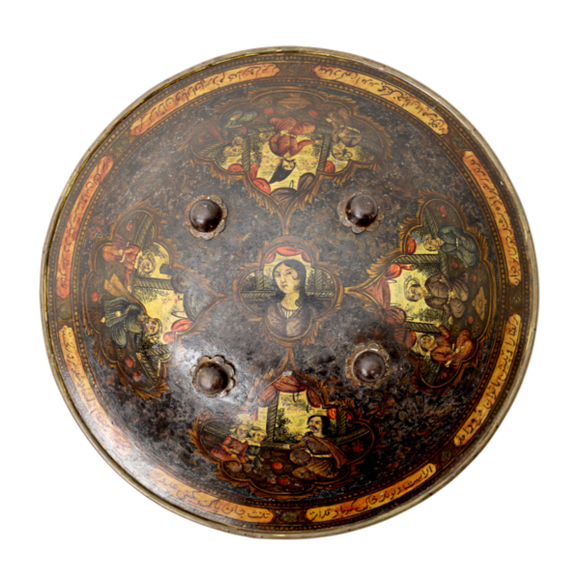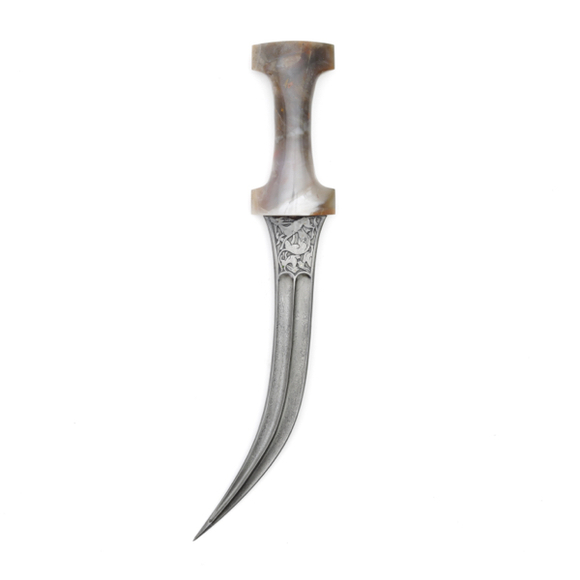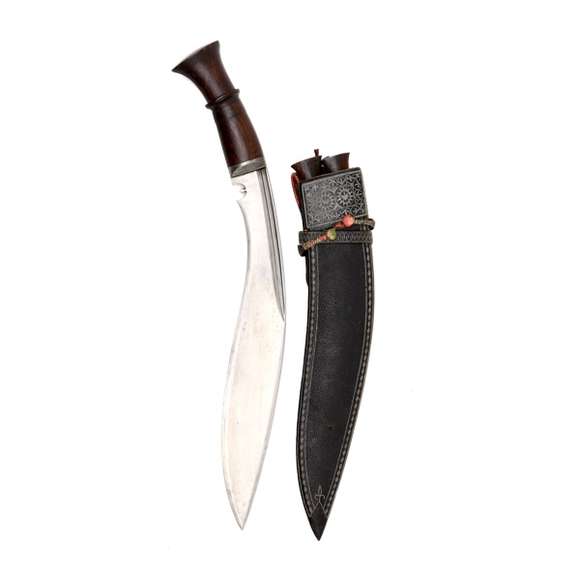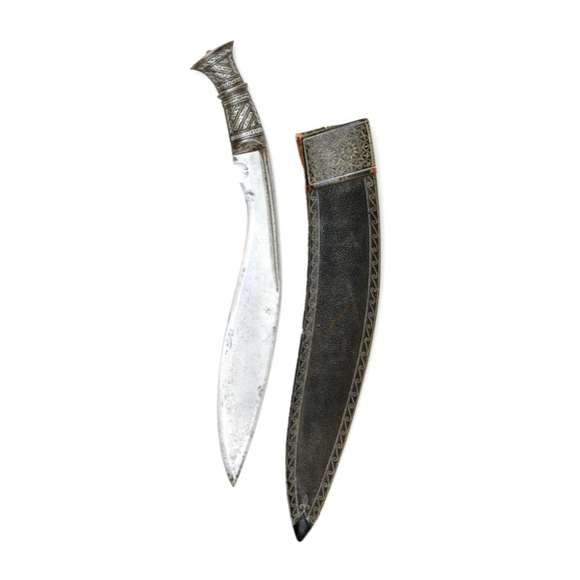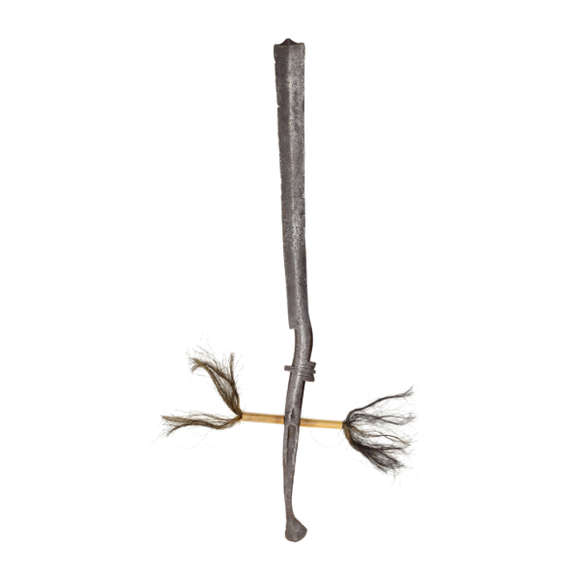Persian steel shield with fine Qajar style painted dome.

Total height 25.5 cm
Bowl heigh 14 cm
Diameter 19.5 cm
Mail 37 cm long
1948 grams
Diameter 44.5 cm
Dome height 7 cm
2506 grams
Total length 54 cm
Plate length 36 cm
651 grams
Iron, wootz steel, leather, cotton, silk, silver, gold
Isfahan, Persia
19th century
Introduction
Persian arms and armor enjoyed widespread fame across the world and naturally found their way to the armories of Ottoman and Indian rulers. Aside from fine craftsmanship, the Persians were known to produce very fine wootz, most notably in the city of Isfahan.
The Isfahan-made wootz steel alone commanded high prices abroad. In a work published in 1888, Hendley described several katar, one made with imported Isfahan steel. The raw steel price is Rs. 40, as opposed to the Rs. 5 for some of the other katar. The Isfahan steel shields mentioned in the same work show an even greater difference, the Isfahan steel for one shield costing Rs. 400, as opposed to the Rs. 15-25 for the others.1
By the late 19th century, the famous arms production in Isfahan started to wane:
“Very beautiful carving, or rather engraving, on metal is still done in Ispahan; and I have some cups of brass, and others of silver, that are probably unique in this kind of metal work. But that, too, is deteriorating ; the good artists find it pays them better to do a quantity of coarse work for the exporting curio dealers than finer and more delicate engravings, which are paid for at a higher rate, but which tax their sight and skill to the uttermost.” 2
"Ispahan is celebrated for its incised work on iron. This "pulad," as it is termed, is beautifully veined and cleverly damascened, being inlaid with thin plates of gold. The specimens are, however, very expensive; as the work is the monopoly of a family, prices are almost prohibitive. This, too, is a dying art."
-Charles James Wills, 1891
The following set of Persian armor contains both fine engravings as well as gold overlay and silver inlay on "pulad"; wootz steel.
Notes to introduction
1. Thomas Holbein Hendley; Ulwar and its Art treasures. W. Griggs & Sons, Ltd. London 1888. Plate XL.
2. Charles James Wills; In the land of the lion and sun. Ward, Lock and co. London. 1891. Page 332.
Description
A very fine matching set of Persian armor consisting of a shield; sipar (سپر), helmet; kulah khud (کلاهخود) and armguard; bazu band (بازوبند) for the left hand. Such sets often come with only one bazu band, and curiously, it is always the left one like seen here.
The entire set is made with Persian wootz steel surfaces, with bold gold overlay. Each piece further has engraved borders with cartouches with Kufic style script done in silver overlay. The cartouches mention Allah الله, Mohammad محمد, and Ali علی. Sometimes three are combined, sometimes two, and sometimes only one is written multiple times.*
*Translation by Manouchehr Moshtagh Khorasani
Personal communication, June 2023
The shield especially is rich in engravings, for which its large surface provides ample opportunity.


The helmet has a long spike on the top, two plume holders, and a retractable nose guard that fixates by means of a wing nut. The neck is protected by a very fine mail consisting of iron and brass rings.
The shield has four bosses on the outer surface, which serve as washers for the four grip rings on the reverse.
The armguard has two separate plates connected with mail that go over the wrist and a leather back mail mitten for the hand.
The inside of all pieces is lined with red cotton fabric.
Intended audience
Fine sets of armor like this were originally meant for elite soldiers, such as the Persian royal guard. By the 19th century, as the army moved away from traditional ways of warfare, the armorers mainly produced for ceremonial occasions, arms for stage performances called Ta'zieh, and export.
With stage performances, the mind usually goes to low-end props, but these weren't just stage plays. The Ta'zieh were religious passion plays that recounted the tragedy of Hussein, the grandson of the Prophet Muhammad. They were performed at set dates and local royalty, and even the Shah himself, took great pride in organizing them in the most lavish manner:
"Among the " properties " may be reckoned horses, mules, camels, etc, all richly caparisoned; lions and other wild beasts from the Shah's menagerie; carpets, shawls, dresses, and suits of armour of every description; European uniforms for the Feringhi ambassador and his suite, who intercede with Yezid for the lives of Hussein's family; and an endless variety of ornamental objects old and new. Some months ago the Shah ordered a collection of ancient metal vases to be made, to add to the splendour of the next Tazieh." 1
-Robert Murdoch Smith, 1876
Fine sets of Persian arms and armor thus found their way through export to the palaces of Ottoman and Indian rulers but also to the arms panoplies that were commonly found in the homes of European gentlemen, particularly the British, who were fond of this.
Notes
1. Robert Murdoch Smith; Persian Art. Chapman and Hall, London. 1880. Pages 38-41.
Condition
Near mint condition. All plated parts are without damage or losses. Only some wear and tear on the inside lining and a few missing rings on the mail.
Dating & attribution
Plate armor, helmets and shields in this general style have been produced from at least the 18th century and continued until the late 19th century.1 Considering the high quality of this set, and the fact the art was already waning in 1891, I suspect that this set dates from around the mid 19th century.
A trader from Isfahan made it to Jeypore in 1883:
A considerable collection of armour and metal vessels made at Ispahdn. in Persia, was brought
to Jeypore by a travelling merchant of that country, and, as it was displayed at the Exhibition, a few photographs of the most interesting examples were taken, with a view of including them in these volumes, in order that a comparison might be drawn between them and Indian work, which undoubtedly owes much to Persia. 2
-Thomas Holbein Hendley, 1883

A set of shield, helmet and armguard brought to Jeypore by the merchant from Isfahan.
This is 1883, and the set already seems quite corroded and having some age.
Judging from the price, this was not made with wootz, as the wootz raw materials easily exceeded Rs. 200 at the time.
Orientalist painter Ludwig Deutsch (1855-1935) depicted numerous Persian shields and helmets in his works. He mostly worked from his studio in Paris and probably had a number of artifacts at his disposal that he worked into his paintings.

Two works by Ludwig Deutsch with Persian armor in it.
Left: The Palace Guard. 1892.
Right: The Inspection. 1893.
Notes
1. See for example a set of "mirrors" in the Ashmolean Museum, dated 1737-1738. Accession number EA1997.176. Waning of the tradition is mentioned by 1891. See Charles James Wills; In the land of the lion and sun. Ward, Lock and co. London. 1891. Page 332.
2. Thomas Holbein Hendley; Memorials of the Jeypore Exhibition 1883: Industrial Art .Volume 3. W. Griggs, London. 1884.
























Nice Persian dagger with fine wootz blade and unusual hilt material.
Made of pasteboard, finely lacquered with roses and nightengales.
An understated, elegant khukuri of substantial proportions with fine layered blade.
With iron, silver overlaid hilt. Its associated scabbard features fine quillwork.
This peculiar sword was used by the Garo people of Assam for fighting, clearing the jungle, and animal…

